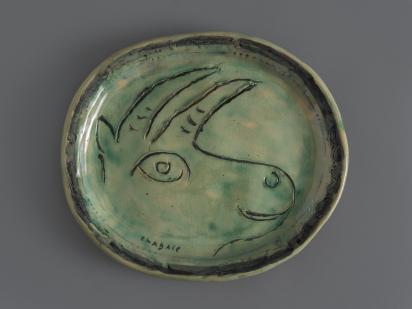In 1952, Chagall created Dish with a Green Goat, one of a series of large enameled dishes with simple, basic forms. The surface features the profile of a smiling goat. The motif, engraved with a knife and drypoint, combined with celadon green, a color chosen by Chagall, gives the piece great formal and graphic purity. The unusual depiction of a goat in profile, emphasizing the roundness of the plate and the head, is an iconographic choice developed by Picasso at the Madoura studio. In 1950, Picasso also used the motif of the goat in profile on plates and dishes, experimenting with various types of decoration, from simple lines to engraving, painting and the addition of elements in relief. While this dish is the only example of a goat’s profile in Chagall's ceramic work, it is a recurring motif in his paintings, echoing his world of reference and sometimes standing in as his animal double. The kindly creature, which seems to view the world with irony and mischief, is different from Picasso's goats, with their lean bodies, protruding bones and tragic expressions. The pared-down composition echoes another ceramic by Chagall, [[The Visiting Donkey 10 760]], which also explores the graphic qualities of point etching, using a continuous line on a solid and then glazed background.
A.G